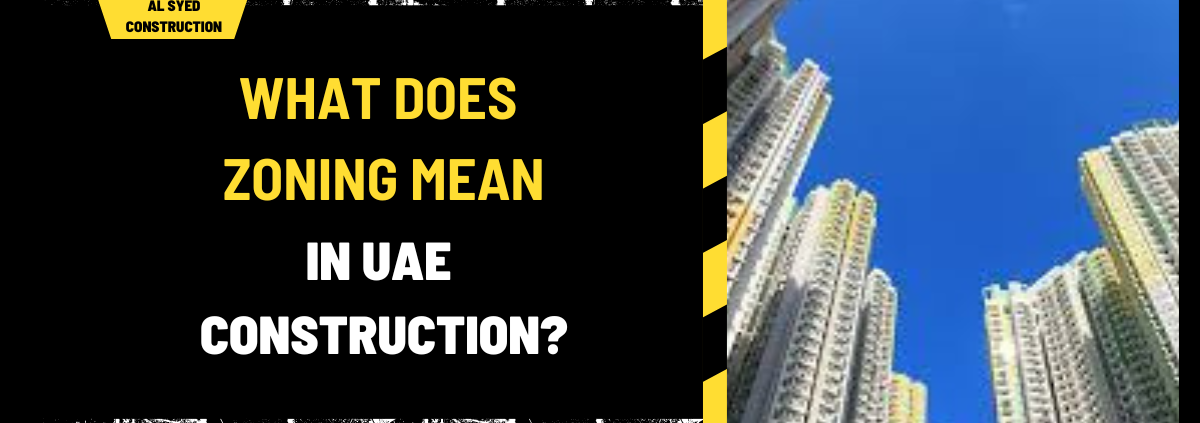What Does Zoning Mean in UAE Construction?
In the field of construction and urban planning, zoning plays a pivotal role in shaping the development and usage of land. Understanding zoning regulations is crucial for developers, architects, and planners to ensure compliance and achieve successful project outcomes. This comprehensive guide will delve into the concept of zoning, its types, applications, and the impact it has on construction projects.
1. Understanding Zoning in Construction
Definition of Zoning
Zoning refers to the division of a city or municipality into different areas, each designated for specific land uses and activities. These regulations are implemented by local governments to manage land development, ensure orderly growth, and maintain the character of neighborhoods.
- Purpose: Zoning is designed to control how land is used, including residential, commercial, industrial, and mixed-use developments.
- Regulations: Zoning laws specify what types of buildings can be constructed, their height, bulk, and the density of development.
Historical Background
Zoning has evolved significantly since its inception in the early 20th century. Initially introduced to separate incompatible land uses, zoning now encompasses a wide range of regulations aimed at promoting sustainable and organized urban development.
2. Types of Zoning
Residential Zoning
Residential zoning is designed to regulate housing development and ensure that residential areas remain suitable for living. It includes various subcategories:
- Single-Family Residential: Areas designated for single-family homes, with restrictions on density and building size.
- Multi-Family Residential: Zones that allow for apartment buildings, townhouses, and condominiums.
- Mixed-Use Residential: Areas where residential and commercial uses can coexist, often seen in urban settings.
Commercial Zoning
Commercial zoning designates areas for business and retail activities. It includes:
- Neighborhood Commercial: Small-scale businesses serving local residents.
- General Commercial: Larger retail and service establishments.
- Regional Commercial: Major shopping centers and malls.
Industrial Zoning
Industrial zoning is intended for manufacturing, warehousing, and heavy industry. It includes:
- Light Industrial: Facilities with minimal impact on surrounding areas, such as assembly plants and warehouses.
- Heavy Industrial: More intensive operations, including factories and large-scale production facilities.
Agricultural Zoning
Agricultural zoning is used to protect farmland and ensure that agricultural activities are preserved. It typically restricts non-farm development and maintains rural character.
Special Purpose Zoning
Special purpose zoning includes areas designated for specific uses, such as parks, schools, and hospitals. These zones address unique needs and ensure that such facilities are appropriately located.
3. Zoning Codes and Regulations
Understanding Zoning Codes
Zoning codes are detailed regulations that govern land use within a zoning district. They specify:
- Land Use: Permitted activities and structures.
- Building Standards: Requirements for setbacks, height limits, and lot coverage.
- Density Regulations: Limits on the number of units or buildings allowed on a parcel of land.
Zoning Maps
Zoning maps visually represent the zoning designations within a municipality. These maps help identify:
- Zoning Districts: Boundaries of different zoning areas.
- Land Use Designations: Specific uses permitted in each zone.
Variance and Special Permits
In some cases, property owners may seek a variance or special permit to deviate from standard zoning regulations. These requests typically require:
- Application: Submission of a formal request to the local zoning board or planning commission.
- Public Hearing: A review process that includes input from the community and stakeholders.
4. Impact of Zoning on Construction Projects
Site Selection and Planning
Zoning regulations significantly impact site selection and project planning:
- Land Use Compatibility: Ensures that new developments are compatible with surrounding land uses.
- Design and Layout: Influences building design, parking requirements, and landscaping.
Compliance and Approvals
Constructing a project requires adherence to zoning codes and obtaining necessary approvals:
- Building Permits: Required for construction activities and modifications to ensure compliance with zoning and building codes.
- Zoning Reviews: Assessments by local authorities to verify that the project meets zoning requirements.
Challenges and Considerations
Developers may face various challenges related to zoning:
- Restrictions: Limitations on building size, height, and land use can impact project feasibility.
- Community Concerns: Local opposition to zoning changes or new developments may influence project outcomes.
5. Zoning and Urban Development
Smart Growth and Sustainability
Zoning plays a crucial role in promoting smart growth and sustainable urban development:
- Mixed-Use Development: Encourages the integration of residential, commercial, and recreational uses to create vibrant, walkable communities.
- Green Building Standards: Zoning codes may include provisions for energy-efficient and environmentally friendly building practices.
Economic Impact
Zoning regulations can influence the economic development of an area:
- Property Values: Proper zoning can enhance property values by ensuring compatible land uses and high-quality development.
- Business Attraction: Well-planned commercial zones can attract businesses and stimulate local economies.
6. Future Trends in Zoning
Flexible Zoning Regulations
Future trends in zoning include more flexible regulations to adapt to changing needs and conditions:
- Form-Based Codes: Focus on the physical form of buildings and their relationship to the public realm, rather than strictly land uses.
- Inclusionary Zoning: Policies that promote affordable housing and equitable development.
Technology Integration
Advancements in technology are enhancing zoning practices:
- Geographic Information Systems (GIS): Improve zoning map accuracy and analysis.
- Smart Zoning Tools: Provide real-time data and insights for better decision-making.
7. Conclusion
Understanding zoning is essential for successful construction and urban planning. It shapes land use, guides development, and ensures that projects are compatible with community goals and regulations. By adhering to zoning codes and embracing emerging trends, developers and planners can contribute to well-organized, sustainable, and thriving communities.




